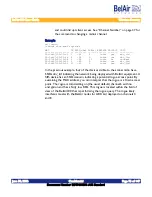
June 30, 2006
Confidential
Document Number BDTM10001-A05 Standard
BelAir100 User Guide
Layer 2 Network Configuration
Example
cd /
/# show ip config
Vlan Address Netmask Broadcast Alloc_Type
----- --------------- --------------- --------------- ------------
101 10.10.1.1 255.255.255.0 10.10.1.255 static
107 142.168.2.240 255.255.255.0 142.168.255.255 dynamic
108 18.18.1.1 255.255.255.0 18.18.1.255 static
132 132.168.2.239 255.255.255.0 132.168.255.255 dynamic
Managing Egress
Node Traffic
In a BelAir network, the LPM port of a node can act as an egress point for the
backhaul traffic of many other nodes. The other nodes may be connected to
the egress node through point-to-point, point-to-multipoint or
multipoint-to-multipoint links.
VLAN Conversion
show egress pvid
set egress pvid {<vlan_id>|untagged}
To use these commands, you must be in
system
mode.
The
set
command is only available if you are logged in as
root
.
These commands let you convert the VLAN tagging of traffic entering or
leaving the LPM port of an egress node. If you specify a VLAN ID, untagged
VLAN packets coming from the LPM port of an egress node are converted to
tagged packets with the specified VLAN ID. Similarly, packets that are tagged
with the specified VLAN ID are sent to the LPM port of the egress node as
untagged VLAN packets.
If you specify the keyword
untagged
instead of VLAN ID, then packets are not
converted as they enter or leave the LPM port of the egress node. The default
setting is
untagged
.
VLAN Filtering
show egress
add egress vlan {<vlan_id>|untagged}
delete egress vlan {<vlan_id>|untagged}
To use these commands, you must be in
system
mode.
The
add
and
delete
commands are only available if you are logged in as
root
.
You can create a list containing up to four VLAN IDs to control which traffic
enters or leaves the LPM port of an egress node. Only packets that are tagged
with a VLAN ID in the list are allowed to enter or leave the LPM port of the
egress node.






























